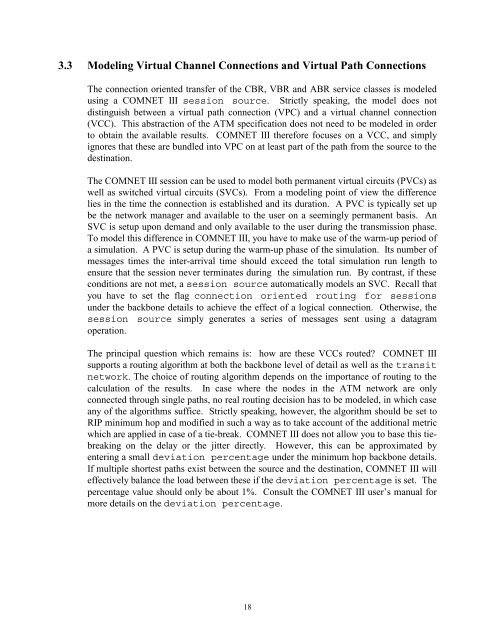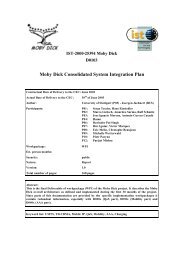COMNET III CACI
COMNET III CACI
COMNET III CACI
You also want an ePaper? Increase the reach of your titles
YUMPU automatically turns print PDFs into web optimized ePapers that Google loves.
3.3 Modeling Virtual Channel Connections and Virtual Path Connections<br />
The connection oriented transfer of the CBR, VBR and ABR service classes is modeled<br />
using a <strong>COMNET</strong> <strong>III</strong> session source. Strictly speaking, the model does not<br />
distinguish between a virtual path connection (VPC) and a virtual channel connection<br />
(VCC). This abstraction of the ATM specification does not need to be modeled in order<br />
to obtain the available results. <strong>COMNET</strong> <strong>III</strong> therefore focuses on a VCC, and simply<br />
ignores that these are bundled into VPC on at least part of the path from the source to the<br />
destination.<br />
The <strong>COMNET</strong> <strong>III</strong> session can be used to model both permanent virtual circuits (PVCs) as<br />
well as switched virtual circuits (SVCs). From a modeling point of view the difference<br />
lies in the time the connection is established and its duration. A PVC is typically set up<br />
be the network manager and available to the user on a seemingly permanent basis. An<br />
SVC is setup upon demand and only available to the user during the transmission phase.<br />
To model this difference in <strong>COMNET</strong> <strong>III</strong>, you have to make use of the warm-up period of<br />
a simulation. A PVC is setup during the warm-up phase of the simulation. Its number of<br />
messages times the inter-arrival time should exceed the total simulation run length to<br />
ensure that the session never terminates during the simulation run. By contrast, if these<br />
conditions are not met, a session source automatically models an SVC. Recall that<br />
you have to set the flag connection oriented routing for sessions<br />
under the backbone details to achieve the effect of a logical connection. Otherwise, the<br />
session source simply generates a series of messages sent using a datagram<br />
operation.<br />
The principal question which remains is: how are these VCCs routed? <strong>COMNET</strong> <strong>III</strong><br />
supports a routing algorithm at both the backbone level of detail as well as the transit<br />
network. The choice of routing algorithm depends on the importance of routing to the<br />
calculation of the results. In case where the nodes in the ATM network are only<br />
connected through single paths, no real routing decision has to be modeled, in which case<br />
any of the algorithms suffice. Strictly speaking, however, the algorithm should be set to<br />
RIP minimum hop and modified in such a way as to take account of the additional metric<br />
which are applied in case of a tie-break. <strong>COMNET</strong> <strong>III</strong> does not allow you to base this tiebreaking<br />
on the delay or the jitter directly. However, this can be approximated by<br />
entering a small deviation percentage under the minimum hop backbone details.<br />
If multiple shortest paths exist between the source and the destination, <strong>COMNET</strong> <strong>III</strong> will<br />
effectively balance the load between these if the deviation percentage is set. The<br />
percentage value should only be about 1%. Consult the <strong>COMNET</strong> <strong>III</strong> user’s manual for<br />
more details on the deviation percentage.<br />
18
















